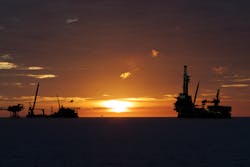OTC 2022: KBR presents strategy for long-distance subsea tiebacks
HOUSTON – Subsea tiebacks of oil discoveries to existing host platforms will continue to be the most sanctioned deepwater projects because they are fast paced and profitable, said Brian Jarrell of KBR at a Wednesday session of the Offshore Technology Conference.
But there is a key problem with this field development strategy, Jarrell said: deepwater liquid subsea tieback distances today are technically constrained to about 35 km, for various expense and field architecture-related reasons. This means that globally, there are numerous discoveries with recoverable reserves that are too small to justify a stand-alone development, between 35 km and 100 km away from an existing host platform, that are effectively “stranded.”
Jarrell presented what he described as “an integrated solution” that could enable producers to develop many of these prospects. This would be accomplished with longer subsea tiebacks, ranging from 35 km out to 100 km, employed in tandem with an array of existing technologies.
The integrated solution consists of three major components: a) an autonomous subsea tieback enabling platform (ASTEP), which is a normally unattended installation (NUI) semisubmersible platform that is moored adjacent to the subsea wells and provides power, chemicals, and controls for the tieback; b) an active thermally managed (ATM) flowline system that ties back the subsea wells to the host platform; and c) a mudline multiphase booster system.
The thermally managed flowline system enables the producer to reduce the amount of subsea architecture, and “has a proven track record,” Jarrell said. The mudline boosting system also has a proven track record, Jarrell added, and helps to solve many drive pressure challenges.
Jarrell said that the ASTEP host platform has several key functionalities, including:
* A power generation module
* A high-voltage electric switchgear module
* A chemical storage and injection module
* A control and communications module for remote well control
* An EOR injection module
* Integrated materials handling system.
The ASTEP platform would be inherently safer, Jarrell added, due to its normally unattended status.
Jarrell said that the ASTEP IS system would minimize host platform modifications and associated production deferment, and increase reservoir recovery by incorporating proven EOR methods. It would also achieve high marks in terms of ESG and HSE metrics, due to its normally unattended platform. He added that ASTEP IS system is readily adaptable to reservoir and regional conditions; and can be repurposed for multiple deployments.
As compared to a conventional subsea tieback, an ASTEP system tieback could bring an offshore producer a savings of 11.2%, for a 30-km tieback. To go to a 50-km tieback, that same producer would be looking at an increase of only 2.7%, as compared to a conventional 30-km tieback. “And no new technology would be needed,” Jarrell underscored.
05.04.2022
About the Author
Bruce Beaubouef
Managing Editor
Bruce Beaubouef is Managing Editor for Offshore magazine. In that capacity, he plans and oversees content for the magazine; writes features on technologies and trends for the magazine; writes news updates for the website; creates and moderates topical webinars; and creates videos that focus on offshore oil and gas and renewable energies. Beaubouef has been in the oil and gas trade media for 25 years, starting out as Editor of Hart’s Pipeline Digest in 1998. From there, he went on to serve as Associate Editor for Pipe Line and Gas Industry for Gulf Publishing for four years before rejoining Hart Publications as Editor of PipeLine and Gas Technology in 2003. He joined Offshore magazine as Managing Editor in 2010, at that time owned by PennWell Corp. Beaubouef earned his Ph.D. at the University of Houston in 1997, and his dissertation was published in book form by Texas A&M University Press in September 2007 as The Strategic Petroleum Reserve: U.S. Energy Security and Oil Politics, 1975-2005.

